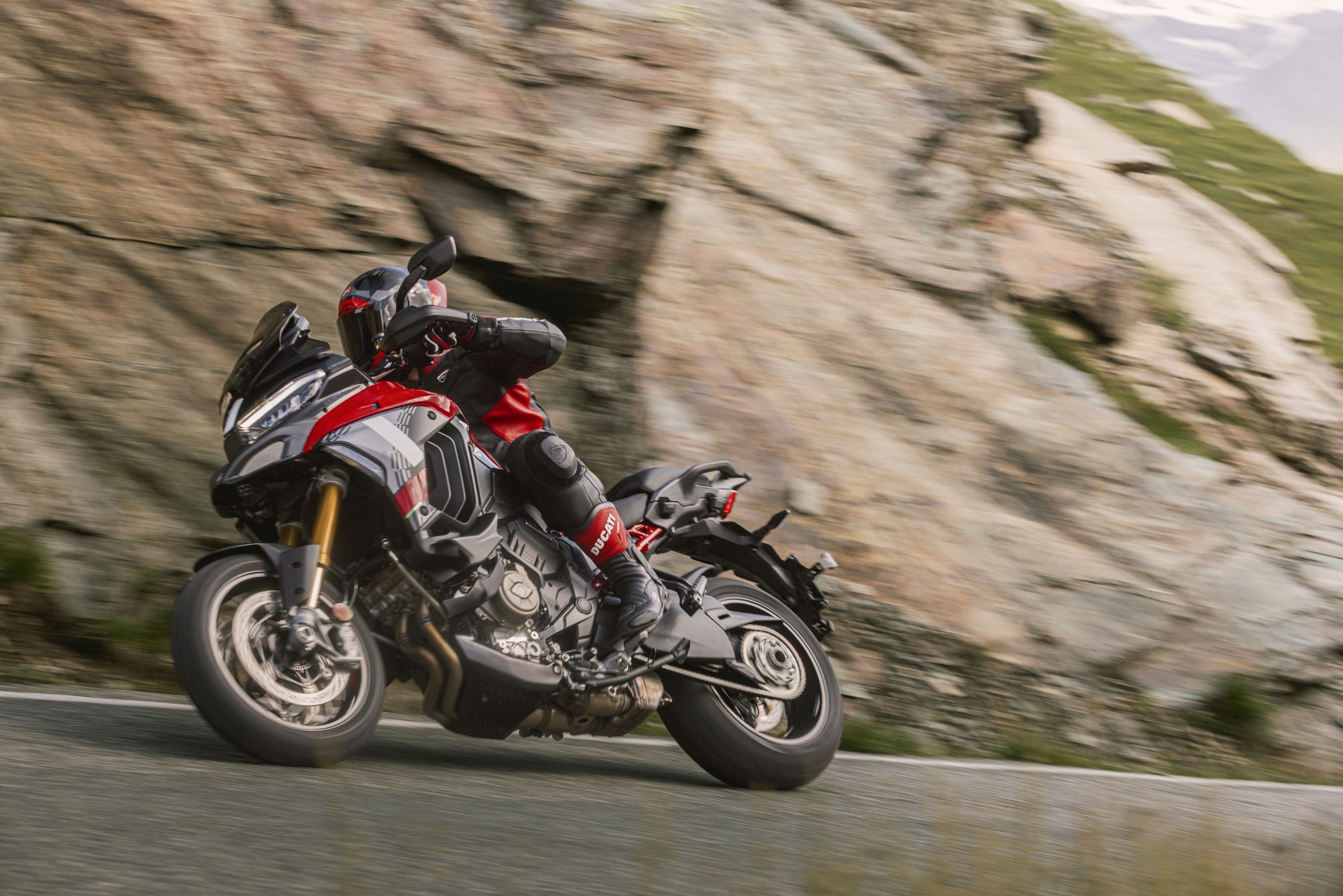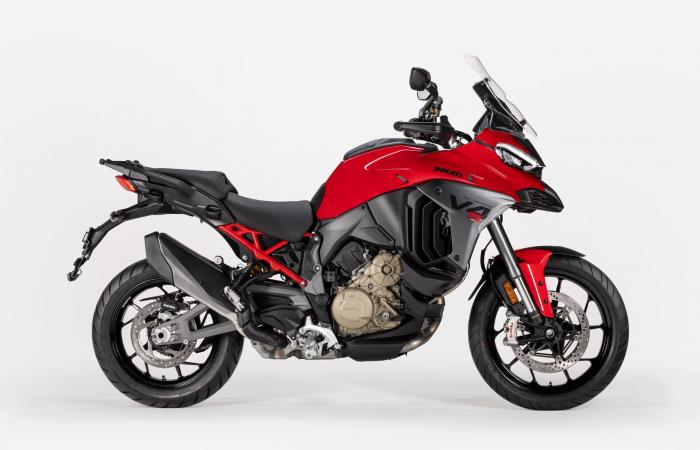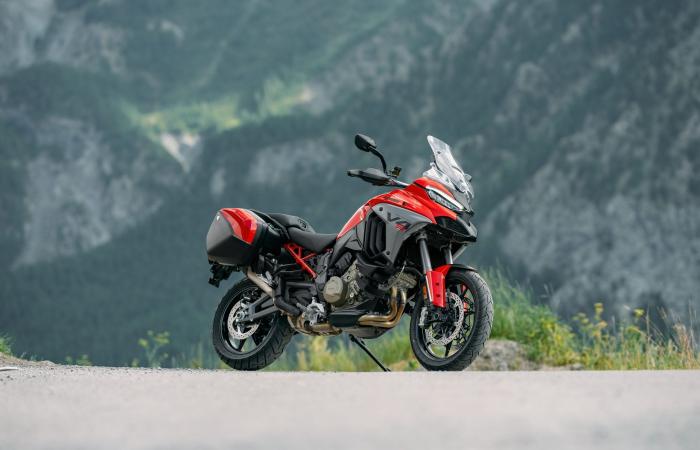This is an update of its Multistrada V4 that Ducati announces for 2025. Or more precisely of its Multistrada V4, V4S and V4 Pikes Peak.
In addition to having an engine that goes from the Euro 5 anti-pollution and anti-noise standards to the Euro 5+ standards, we find a series of modifications made by the Italian manufacturer on its Multistrada V4 and which take up what was introduced on the Multistrada V4 Rally (read our test in Sardinia).
The most important, one would say if one knows the average consumption of the V4 engine of these Multistradas, is the adoption of the system of deactivation of the rear cylinder bank of the engine other than when stationary. In certain heat conditions and depending on the throttle control and other factors, the electronics of the Motorcycle “turn off” the two rear cylinders of the V4.
When you twist the throttle fully, or the engine needs more power and torque, the same electronics reactivate them imperceptibly (we were able to test on the Rally). The two beneficial effects are improved fuel consumption – by 6% according to Ducati engineers. Knowing that the three models concerned for 2025, the V4, the V4S and the V4 Pikes Peak, have a smaller fuel tank than that of the V4 Rally.
There is also less heat released, but on this last point, Ducati has already thought carefully about the evacuation of heat on its Multistrada V4, and of course a reduction in the quantity of pollutant gas emissions, which can only go in the direction of the Euro 5+ standards.
Although the fuel tank does not gain in capacity on these new Multistrada V4 and V4S, and you still have to use the V4 Rally to get 30 litres of fuel, compared to 20 on the other two models, the latter inherit another little extra from the Rally: the luggage support and attachment bars are offset towards the rear to give the passenger more freedom to get on and off the saddle.
But the passenger seat itself is not longer, unlike that of the Multistrada V4 Rally.
Otherwise, Ducati has delved back into the electronics of its Multistrada V4 and V4S, and offers several new features. The appearance of the engine brake control (three intervention levels to choose from) comes directly from what was done on the Rally. There is also a new “Wet” mode, which reduces the maximum power, gives a response to the soft acceleration command and increases the degree of intervention of the electronic driving aids (especially the traction control).
The Enduro mode also has reduced power, but with a fairly direct throttle response, and a specific calibration of the electronic assistance (less intrusive), to allow a little possible slippage during acceleration and allow the front wheel to lift. And remove the angle-sensitive function of the ABS. Nothing out of the ordinary, in short.
As on the 2025 Panigale V4S that was just presented by Ducati (read our article), the 2025 Multistrada V4 and V4S use a new calculation strategy (an algorithm) to link the data provided by the inertial measurement unit and other sensors to the interventions of the various electronic driving assistance systems. In Bologna (the brand’s headquarters), they call it DVO, for Ducati Vehicle Observer. In short, it is finer and more subtle than what existed until now.
This DVO was first introduced on the new version (2025) of Ducati’s Superbike, the Panigale V4 (read our presentation).
On the braking side, the electronics of these new Multistradas combine the action of the front brake and that of the rear brake, as well as that of the rear brake and the front brake. It can thus happen (it is the electronics that decide when and how) that the rear brake is activated in support of the front if the rider only uses the front brake. And the opposite when he (or she) only uses the rear brake.
It doesn’t stop there. On the Multistrada V4S 2025, the semi-active electronic suspensions can now be adjusted independently of the chosen riding mode. And via a dedicated button. This doesn’t just concern the preload, but also and above all the damping law (compression and rebound), which, let’s remember, adapts continuously to the driving conditions and riding impulses.
You can choose between a damping that tends to be sporty and therefore rigid and a damping that is more of the comfortable type. In both cases, the electronics will temporarily stiffen the settings if you adopt a sporty driving style and the surface deteriorates, but it will not do it in the same way.
Ducati adds that it has added a sensor in the fork at the front, which acts as a bump detector. This also allows the action of the electronic suspensions to be refined.
Still for the new V4S, it gains an automatic lowering function (which can be completely deactivated if preferred) which lowers the rear of the motorcycle (via the electronic suspensions) by a value that can range from 15 to 30 mm depending on the load carried, as soon as you go below a certain speed. And which raises everything again as soon as you exceed 50 km/h.
With this little novelty, Ducati is getting in line with the competition (BMW, Triumph, Harley-Davidson), which has indeed very recently introduced an automatic lowering. The Multistrada V4, until now, had a similar function, but which had to be triggered by the rider via a long press on the suspension adjustment button, on the left stalk.
On both Multistrada V4 and V4S models, the chassis, in its “mechanical” components, also changes. The rear swingarm mounting pivot is positioned a millimeter higher. According to Ducati, this is enough to noticeably improve the bike’s behavior during acceleration with rider, passenger and luggage, preventing the rear end from “sagging.” To be honest, it’s quite possible, but we have never really noticed any discomfort in this area so far, even with two people on the bike.

The inverted telescopic fork at the front and the single shock absorber at the rear are different on these evolutions of the models. At the rear, there is more possibility of adjusting the preload (+8 mm compared to the previous shock absorber).
The rear brake disc increases from 265 mm in diameter to 280, and the brake pedal is all-new and is inspired by that of the V4 Rally. According to Ducati, it offers better grip for the rider’s foot.
Revised headlights and brakes
On the subject of safety while riding, Ducati has modified the front headlight, with the aim of reducing the shadow area just in front of this projector which, as a reminder, has a cornering light function to better illuminate the inside of said bends.
There is one more little extra in this area. In case of hard braking, for example in an emergency, the Multistrada’s system will not only illuminate the rear light differently, it will also make the two rear direction indicators flash as soon as you are below 15 km/h. The rear part gains an additional light, which is a fog light. And apparently it turns on automatically.
The systems using radars (available only on the V4S) become more complete. We still have the warning of objects in the blind spots, and the adjustable and self-adaptive cruise control. What is new is a warning of risk of collision at the front.
Finally, Ducati has subtly reworked the aesthetics of its Multistrada V4 and V4S, by changing the distribution of colors on the various covers and fairings. It’s subtle, and in our humble opinion, it’s quite successful.
The update of the Multistrada range for 2025 is not limited to the V4 and V4S. The V4 Pikes Peak also receives targeted improvements. This includes the raising of the swingarm mounting pivot (which is a single-sided swingarm on the Pikes Peak, compared to a bilateral swingarm on the V4 and V4S), or the larger diameter rear brake disc.

There’s also a new livery, inspired by MotoGP and Ducati’s other racing activities, and a titanium Akrapovic exhaust that’s now Euro 5+ compatible.
It should be remembered that the Multistrada V4 Pikes Peak is distinguished by a 17-inch diameter front wheel, which is sportier on the road, by a more forward driving position with higher and more rearward footrests, and by a set of electronically controlled semi-active suspensions supplied by another manufacturer (Öhlins).
The maximum power is the same: 170 horsepower, just like the V4 engine with a counter-rotating shaft. Another distinguishing feature is the single-sided swingarm at the rear, instead of the two-arm swingarm of the other Multistradas (except for the Multistrada V4 RS, which is close to the Pikes Peak but goes even further by using the engine of the Panigale V4 Superbike).
The rest is concentrated in the program that manages the semi-active electronic suspensions on the Pikes Peak. In summary, and according to Ducati, the sporty side is even more so in the Sport suspension mode, and the comfort is even more present in the Sport mode.
As with its less sporty sisters, for 2025, the basic damping laws can be adjusted independently of the driving modes (which define the torque and power curves in response to the acceleration command, as well as the interventions of the other driving assistance systems). This is new.
The Wet riding mode makes its appearance and completes the Pikes Peak’s range (which includes Sport, Road, Rain and Race modes – no Enduro mode).
The 2025 Multistrada V4 is available from 21,490 francs, from October, in the only color red (“Ducati Red”).
Its big sister, the Multistrada V4 S, is available from 25,190 francs, in red, or, for 400 francs more, in black (“Thrilling Black”) or white (“Arctic White”).
The above-mentioned radars can be added to this model, as well as various equipment packs: Radar (for 26,340 francs), Radar & Travel (with hard plastic cases, central stand, heated saddles and handles, for 28,220 francs), Sport Travel & Radar (with lighter forged rims, for 29,620 francs), or Adventure Travel & Radar (spoke rims and aluminium cases, for 30,220 francs).
Both the V4 and the V4S are available with spoked rims instead of spoke wheels. The new Multistrada V4 Pikes Peak is priced from 32,790 francs, in a unique livery. For completeness, we add that the V4 Rally (30-liter tank, spoked rims, longer saddle) is priced from 28,090 francs, and that the V4 RS is priced at 37,990 francs.
To find out more, you can visit the Swiss Ducati website, or contact our partners in our Swiss Motorcycle Professionals Directory: Ares Motors in Echandens (VD), Ducati Geneva in Vernier, Compétition Park in Neuchâtel, or hostettler moto in Sion (VS).
Source: comm. Ducati







